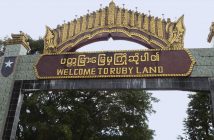Moulmein, renamed Maylamyine (pronounced “more-la-mean”) is the capital of Mon State in the Southeastern Myanmar. It is the 4th largest city in Myanmar after Yangon, Mandalay and Naypyidaw; however, the city looks like a large small town.
Nowadays Mawlamyine is an off beaten track site with the rich history, the colonial buildings lining in quiet streets, World War II era wooden buses, Siam-Burma “death railway”, the market and seafood… All makes the city a fascinating place to visit!
What to See
- Kyaik Than Lan Pagoda: The pagoda is located up on the hill with the beautiful view of the surrounding, especially in sunset. Around the main pagoda is 34 smaller stupas encircled. It is said that the place contained a relic of Buddha hair.
- Besides pagodas Mawlamyine also have many other worship sites such as: St Patrick’s Roman Catholic Church, the Soorti Sunni Jamai Mosqueand the red brick St Matthew’s church…
- Taking the boat from the west of Mawlamyine to Bilu Island is enjoyable. There are 64 villages making handicrafts along the street of the island, such as: coconut mats, wooden instruments, bamboo hats, rubber bands…
As foreigners aren’t allowed to stay overnight in the island, you are suggested to take the ferry in the morning, spend half day on the tuk-tuk ride, explore the rustic atmosphere and interact with friendly locals. - The Thanlwin bridge, the longest road and rail bridge (11,000 feet) of the country. Crossing over Thanlwin river, the bridge connects Myanmar’s south eastern region with Yangon.
- The Strand Roadis a pleasant place in sunset. Here you can leisurely experience the view with a wide range of waterfront cafes and restaurants.
- Thanbyuzayat is located 60 kilometers from the south of Mawlamyine. It is now the famous Allied War Memorial Cemetery. The cemetery was built for Allied soldiers from the British Commonwealth who died in battle in Burma during the 2nd World War.
Meanwhile, the Death Railway Museum Thanbyuzayat exhibits the photos, paintings and sculptures about the railway building process.


 (1,119 votes, average: 4.64 out of 5)
(1,119 votes, average: 4.64 out of 5)

